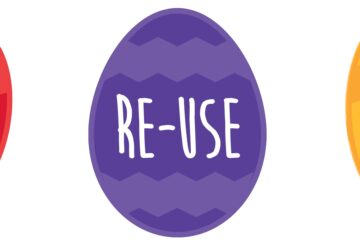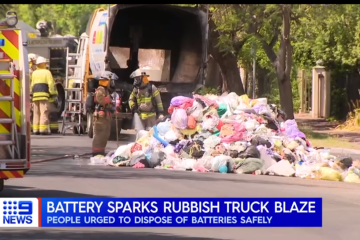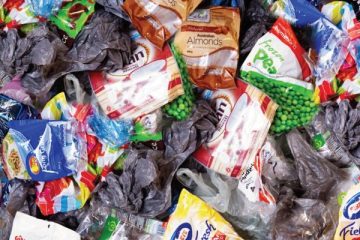
View video footage from East Waste trucks here: https://www.adelaidenow.com.au/news/what-not-to-put-in-your-yellow-bin/video/add8e14eaf712f4d1a1660f5f5697e2c
Colin James, The Messenger September 6, 2020 11:39am
Poor kerbside behaviour by South Australian households is creating $20 million each year in extra waste management costs, according to industry experts.
Incorrect use of general rubbish, recycling and green waste bins continues to present widespread problems, with councils across the state embarking on public education campaigns.
Contamination remains the biggest issue with yellow bins while too much food waste is being put into red or blue bins which should be going into green bins.
East Waste chief executive Rob Gregory said Adelaide households annually sent enough food waste to landfill to cover Adelaide Oval to a depth of five metres.
Mr Gregory said a recent audit by East Waste had shown three quarters of food put into red or blue bins — instead of green bins — was edible.
“Keeping food waste out of the landfill bin and putting it into the green organics bin presents one of the biggest environmental and economic opportunities we have,” he said.
Various official programs and strategies are being implemented in a bid to reduce the weight of red and blue bins going to landfill by diverting food waste and other organic material to green bins.
The State Government is seeking public input on a strategy to encourage more households to put their food waste into green bins, which are taken to privately-operated plants to produce compost.
Reducing the weight of rubbish transported to landfills — which charge gate fees at their weighbridges — has become paramount as local government struggles with rising costs for waste management.
Councils are paying almost $200 for each tonne of rubbish taken to landfill following dramatic increases in the Solid Waste Levy introduced late last year by the State Government.
It is calculated the levy increase — from $100 to $143 a tonne — already has cost councils an extra $30m while poor kerbside behaviour is adding another $20 million each year.
Mr Gregory said East Waste — a consortium operated by seven councils — had estimated Adelaide’s 17 councils could save $13.5m a year if food and organic material such as hair, bones, tissues and paper towel went into green bins, instead of red and blue bins which go to landfill.
“Another $2.5 million could be saved if all recyclables went into the yellow bin rather than the landfill bin, which gives a total saving of around $16 million just if we recycled properly,” he said.
A further $4m could be saved if households stopped putting material into yellow bins which caused contamination — taking the total potential savings to $20m.
“We need to reduce contamination within the yellow bin in order to maximise the next use of the resources contained in that waste stream,” he said.
“At present we are wasting a number of resources and making recycling more expensive than it needs to be, because of avoidable contaminants in the yellow bin.”
Providing uncontaminated recycling material was crucial to the success of the so-called “circular economy”, which creates products made from recycled glass, plastic, paper, cardboard and metal.

Mr Gregory said there needed to be more South Australian participants in the state’s “circular economy” to ensure there was a market for material put into yellow bins.
“It is critical to encourage a circular economy where the material is reused numerous times,” he said.
“Ideally, we want this circularity occurring wholly within South Australia where we are managing and processing our own waste resources and deriving the economic benefits and jobs that come with this.”
Mr Gregory said the state’s commercial composting industry – where two companies, Jeffries and Peats, were among those converting green waste into various garden products – was “the perfect example of how we can achieve this outcome”.
PLASTIC BAGS USED FOR NEW WALKWAYS

South Australians are walking on millions of plastic bags every time they go to several popular beaches and parks.
The bags have been collected by supermarket giants Woolworths and Coles for processing by a Victorian company, Replas, at its Ballarat factory.
Replas uses plastic pellets produced from the bags to produce a range sleepers, posts, bollards, decking, planks and park benches purchased by various South Australian councils.
The recycled plastic has been used for projects such as the Gilberton swing bridge, Victor Harbor boardwalk, Adelaide Oval’s picket fence, Brighton jetty and Seacliff boardwalk.


Replas, in partnership with a Queensland company Wagners, recently won a $230,000 contract to replace a wooden boardwalk at Tumby Bay, on Eyre Peninsula.
The company’s SA distributor, Robbie Westley, said it made its products from recycled “soft plastics” such as shopping bags, hospital waste and nappy trimmings.
Mr Westley said projects such as a staircase at Prospect Hill, on Kangaroo Island, consisted of “tens of millions of plastic bags”.
“Our content is almost 100 per cent recycled plastic,” he said.
Mr Westley said he was working on another project to use recycled plastic bags to redeck the Birkenhead Bridge at Port Adelaide.https://imasdk.googleapis.com/js/core/bridge3.407.2_en.html#goog_8166327

Ditching single-use shopping bags is just the beginning. There are more things we can do to help reduce the amount of synthetic non-biodegradable rubbish in our landfill.
NORTHERN RESIDENTS WALK ON GLASS
Recycled glass is being used to make footpaths in Adelaide’s northern suburbs.
Three northern councils have spent $4 million on a new machine to process glass fragments at the waste transfer facility operated by the Northern Adelaide Waste Management Authority (NAWMA) at Edinburgh.
NAWMA chief executive Adam Faulkner said a trial was starting this week with Boral to use shattered glass mixed with aggregate to make footpaths for Playford Council.
Most of the fragments were gathered from bottles and jars which shattered in rubbish trucks during kerbside collections.
Mr Faulkner said the project was “the most powerful illustration of the circular economy in action”.
“Householders recycle responsibly in their yellow top bins, it gets collected, and now along with clean paper and cardboard, plastics, aluminium and metals, we catch another 10,000 to 12,000 tonnes of broken glass for our constituent councils to buy back into their civil programs,” he said.
Mr Faulkner said the glass being used for the footpath trials was unsuitable to be used to produce bottles and would have ended up in landfill.
“We’re pleased to see the safe and responsible uptake of recycled glass as a replacement for virgin aggregate or virgin sand,” he said.
Salisbury and Gawler councils also are looking at using the recycled glass for footpaths.
Related articles:


